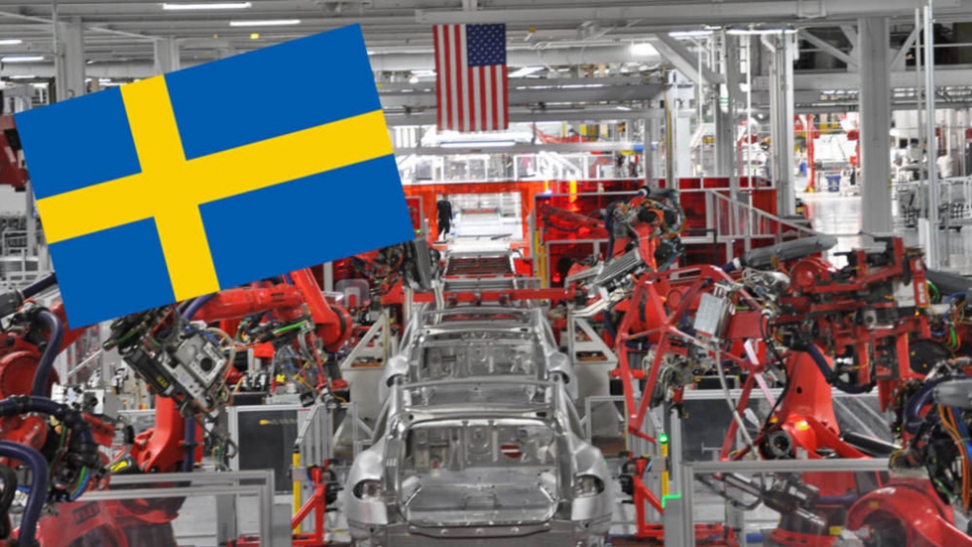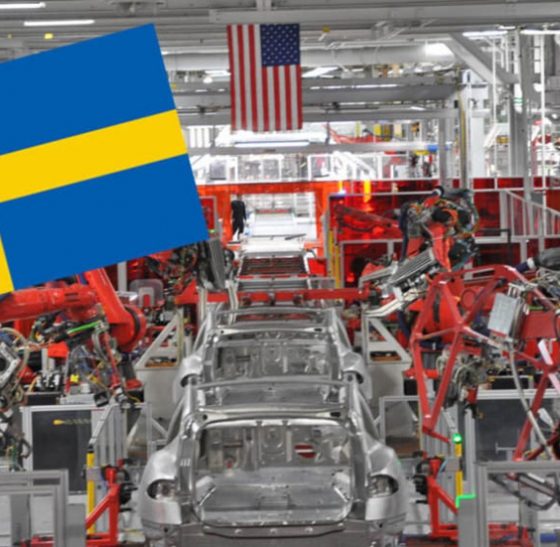

News
Why Sweden is primed to become home of Tesla’s European factory
Could lightning strike twice for Tesla? It’s current factory was once used by NUMMI — a joint venture by Toyota and General Motors — to make cars in Fremont. Tesla was able to purchase it for pennies on the dollar. After years of extensive upgrades, it is now one of the most automated and efficient production facilities in the world.
Saab, on the other hand, used to manufacture world class automobiles at its factory in Trollhattan, Sweden. That factory is now owned by NEVS — an acronym for New Electric Vehicle Sweden. The principal owner of NEVS is National Modern Energy Holdings Ltd, a Beijing based company founded in 2004 by Kai Johan Jiang. NEVS has a contract with Panda New Energy Company to provided it with 150,000 electric versions of Saab’s last production midsize sedan, the 9-3 sedan.
Making 150,000 cars over 4 years is not enough to keep the factory fully operational — it’s capacity is far greater than that. All of which has several people in Sweden thinking it would be the perfect place for Tesla to locate its first European factory.
There are several factors that could make Trollhattan attractive to Tesla other than the fact that it has a large factory sitting practically idle. It has a large pool of workers who are familiar with building automobiles from the days when Saabs were manufactured there. It also is near Gothenburg, with its international railway hub and large ocean freight terminal.
Sveriges Radio P4 Väst says that a group of local stakeholders is working to attract Tesla to the area. According to reports, the group includes Business Sweden and automotive supplier FKG. Fredrik Sidahl, CEO of FKG, confirms that the group has been in contact with Tesla. Everyone involved is tight lipped when it comes to details, though.
Sidahl says the group is confident that it can revive the car industry in Sweden. “I think the possibilities are quite good because Sweden has a well developed infrastructure with suppliers and expertise in building great vehicles with high technical standards.”
A spokesperson for NEVS would not comment directly on the report but said in an e-mail to Radio P4 Väst that the company could be a valuable partner for other car manufacturers in terms of both production and development. “It’s part of our strategy to increase the capacity of our plant but we do not comment on the dialogue around this.”
Local automotive journalist Benny Christensen says, “It would be really fun if Sweden got the assignment. There are many people who think it is sad to see the car factory in Trollhattan idle. I think that whoever wins the [Tesla factory] will be those who put forth the best organized proposal based purely on economic and practical considerations. Everything from infrastructure to environmental and tax policies will undoubtedly be crucial,” he says.
Sweden is not alone in its attempt to lure Tesla. Finland’s Minister of Industry has indicated his country has its eye on the Tesla factory. There are interested parties in Germany, France, Spain, and Portugal as well. Tesla has let nothing slip about its intentions after Elon Musk’s whirlwind tour of the Continent last summer.
Is a mostly idle factory enough to seal the deal for Sweden? Even though cars were manufactured there up until 5 years ago, much of the tooling and equipment would likely need to be replaced. Elon Musk is intent on reinventing manufacturing — building the machine that builds the machine, as he calls it. It’s possible Tesla would prefer to construct its own facility utilizing all the efficiency strategies it can muster rather than spending money to reconfigure an existing space.
An announcement from Tesla about where its next factory will be is anticipated later this year, probably after production of the Model 3 gets started and begins running smoothly.
Hat tip: Leif Hansen

News
Tesla starts showing how FSD will change lives in Europe
Local officials tested the system on narrow country roads and were impressed by FSD’s smooth, human-like driving, with some calling the service a game-changer for everyday life in areas that are far from urban centers.

Tesla has launched Europe’s first public shuttle service using Full Self-Driving (Supervised) in the rural Eifelkreis Bitburg-Prüm region of Germany, demonstrating how the technology can restore independence and mobility for people who struggle with limited transport options.
Local officials tested the system on narrow country roads and were impressed by FSD’s smooth, human-like driving, with some calling the service a game-changer for everyday life in areas that are far from urban centers.
Officials see real impact on rural residents
Arzfeld Mayor Johannes Kuhl and District Administrator Andreas Kruppert personally tested the Tesla shuttle service. This allowed them to see just how well FSD navigated winding lanes and rural roads confidently. Kruppert said, “Autonomous driving sounds like science fiction to many, but we simply see here that it works totally well in rural regions too.” Kuhl, for his part, also noted that FSD “feels like a very experienced driver.”
The pilot complements the area’s “Citizen Bus” program, which provides on-demand rides for elderly residents who can no longer drive themselves. Tesla Europe shared a video of a demonstration of the service, highlighting how FSD gives people their freedom back, even in places where public transport is not as prevalent.
What the Ministry for Economic Affairs and Transport says
Rhineland-Palatinate’s Minister Daniela Schmitt supported the project, praising the collaboration that made this “first of its kind in Europe” possible. As per the ministry, the rural rollout for the service shows FSD’s potential beyond major cities, and it delivers tangible benefits like grocery runs, doctor visits, and social connections for isolated residents.
“Reliable and flexible mobility is especially vital in rural areas. With the launch of a shuttle service using self-driving vehicles (FSD supervised) by Tesla in the Eifelkreis Bitburg-Prüm, an innovative pilot project is now getting underway that complements local community bus services. It is the first project of its kind in Europe.
“The result is a real gain for rural mobility: greater accessibility, more flexibility and tangible benefits for everyday life. A strong signal for innovation, cooperation and future-oriented mobility beyond urban centers,” the ministry wrote in a LinkedIn post.
News
Tesla China quietly posts Robotaxi-related job listing
Tesla China is currently seeking a Low Voltage Electrical Engineer to work on circuit board design for the company’s autonomous vehicles.

Tesla has posted a new job listing in Shanghai explicitly tied to its Robotaxi program, fueling speculation that the company is preparing to launch its dedicated autonomous ride-hailing service in China.
As noted in the listing, Tesla China is currently seeking a Low Voltage Electrical Engineer to work on circuit board design for the company’s autonomous vehicles.
Robotaxi-specific role
The listing, which was shared on social media platform X by industry watcher @tslaming, suggested that Tesla China is looking to fill the role urgently. The job listing itself specifically mentions that the person hired for the role will be working on the Low Voltage Hardware team, which would design the circuit boards that would serve as the nervous system of the Robotaxi.
Key tasks for the role, as indicated in the job listing, include collaboration with PCB layout, firmware, mechanical, program management, and validation teams, among other responsibilities. The role is based in Shanghai.
China Robotaxi launch
China represents a massive potential market for robotaxis, with its dense urban centers and supportive policies in select cities. Tesla has limited permission to roll out FSD in the country, though despite this, its vehicles have been hailed as among the best in the market when it comes to autonomous features. So far, at least, it appears that China supports Tesla’s FSD and Robotaxi rollout.
This was hinted at in November, when Tesla brought the Cybercab to the 8th China International Import Expo (CIIE) in Shanghai, marking the first time that the autonomous two-seater was brought to the Asia-Pacific region. The vehicle, despite not having a release date in China, received a significant amount of interest among the event’s attendees.
Elon Musk
Elon Musk and Tesla AI Director share insights after empty driver seat Robotaxi rides
The executives’ unoccupied tests hint at the rapid progress of Tesla’s unsupervised Robotaxi efforts.

Tesla CEO Elon Musk and AI Director Ashok Elluswamy celebrated Christmas Eve by sharing personal experiences with Robotaxi vehicles that had no safety monitor or occupant in the driver’s seat. Musk described the system’s “perfect driving” around Austin, while Elluswamy posted video from the back seat, calling it “an amazing experience.”
The executives’ unoccupied tests hint at the rapid progress of Tesla’s unsupervised Robotaxi efforts.
Elon and Ashok’s firsthand Robotaxi insights
Prior to Musk and the Tesla AI Director’s posts, sightings of unmanned Teslas navigating public roads were widely shared on social media. One such vehicle was spotted in Austin, Texas, which Elon Musk acknowleged by stating that “Testing is underway with no occupants in the car.”
Based on his Christmas Eve post, Musk seemed to have tested an unmanned Tesla himself. “A Tesla with no safety monitor in the car and me sitting in the passenger seat took me all around Austin on Sunday with perfect driving,” Musk wrote in his post.
Elluswamy responded with a 2-minute video showing himself in the rear of an unmanned Tesla. The video featured the vehicle’s empty front seats, as well as its smooth handling through real-world traffic. He captioned his video with the words, “It’s an amazing experience!”
Towards Unsupervised operations
During an xAI Hackathon earlier this month, Elon Musk mentioned that Tesla owed be removing Safety Monitors from its Robotaxis in Austin in just three weeks. “Unsupervised is pretty much solved at this point. So there will be Tesla Robotaxis operating in Austin with no one in them. Not even anyone in the passenger seat in about three weeks,” he said. Musk echoed similar estimates at the 2025 Annual Shareholder Meeting and the Q3 2025 earnings call.
Considering the insights that were posted Musk and Elluswamy, it does appear that Tesla is working hard towards operating its Robotaxis with no safety monitors. This is quite impressive considering that the service was launched just earlier this year.








